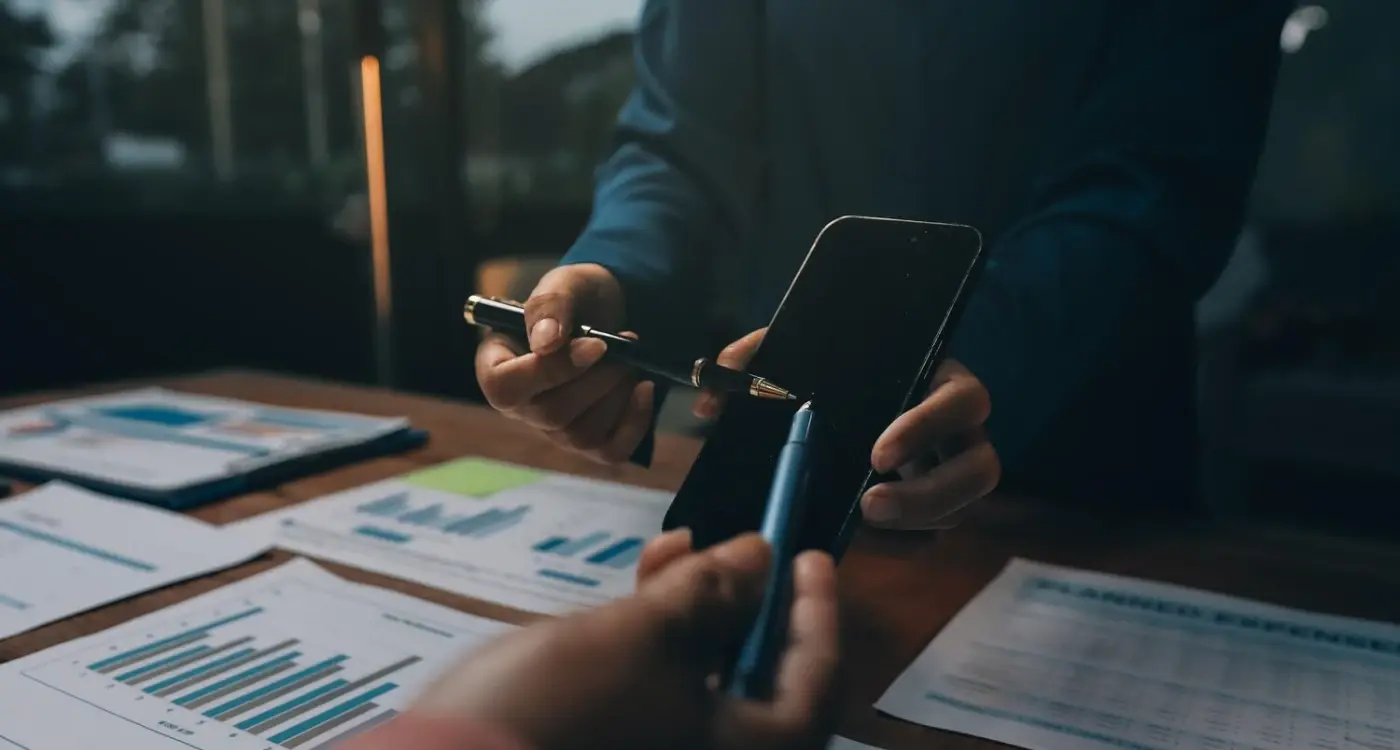What Makes Your Mobile App Valuable to Potential Buyers?
As mobile app developers who've guided countless entrepreneurs through successful exits, we understand that deciding to sell your app can feel both exciting and overwhelming. Whether you've poured years into building your mobile application or simply feel it's the right time to explore acquisition opportunities, knowing your app's true value is crucial for a successful sale.
The true value of a mobile app lies not just in its code, but in the complete story it tells to potential buyers - from its market position to its future potential.
Throughout our years of experience, we've observed that many app creators struggle to identify and communicate their app's genuine worth. They often focus solely on download numbers or revenue figures, overlooking crucial app valuation factors that buyers scrutinise during acquisition.
This comprehensive guide will walk you through everything you need to know about preparing your mobile app for sale and maximising its business value. We'll explore the key metrics buyers care about, help you develop a robust app exit strategy, and share practical insights on making your application attractive to potential acquirers.
From understanding technical quality to assessing user engagement analytics, we'll cover all aspects that contribute to your app's market value. Whether you're actively planning to sell or simply want to build your app with future acquisition in mind, this guide will provide you with actionable steps to enhance your app's worth.
Let's begin by examining how buyers evaluate mobile applications and what makes certain apps more valuable than others in today's dynamic marketplace.
Understanding Your App's Market Value
Determining your mobile app's true market value can feel like trying to price a unique piece of art - there's both science and intuition involved. At Glance, we've guided numerous app creators through this evaluation process, and we've learned that understanding your app's worth goes far beyond just looking at your download numbers.
Think of your app's market value as a puzzle made up of several crucial pieces. Just as you wouldn't sell a house without knowing its unique features and comparing it to similar properties in the neighbourhood, you need to thoroughly understand what makes your app valuable in today's dynamic marketplace.
Core Value Drivers to Consider
- Monthly recurring revenue and growth trajectory
- Active user base and engagement metrics
- Unique technological innovations or patents
- Market positioning and competitive advantages
- Quality of code and technical infrastructure
- Potential for scaling and expansion
Remember that famous British shopping app that sold for millions? Their success wasn't just about their clever interface - it was their deep understanding of their market value that led to such a profitable exit. Similarly, your app's worth isn't just about current performance; it's about its potential in the hands of the right buyer.
We've seen apps that seemed modest at first glance command impressive valuations because they understood and could demonstrate their true market value. Whether you're running a fintech solution or a lifestyle app, knowing your worth helps you make informed decisions about investment, growth, and eventual exit strategies.
Key Revenue and Growth Metrics
When preparing your mobile app for potential buyers, understanding your revenue and growth metrics is absolutely crucial. These numbers tell the story of your app's financial health and future potential - they're like your app's report card to investors.
Essential Revenue Metrics
Start by examining your Monthly Recurring Revenue (MRR) and Annual Recurring Revenue (ARR). Think of these as your app's steady monthly or yearly income - the kind of predictable revenue that makes buyers' eyes light up. Track your revenue growth rate too; we've found that apps showing consistent 20% year-over-year growth tend to attract more serious buyers.
Growth Indicators That Matter
Beyond basic revenue figures, buyers will want to see your Customer Acquisition Cost (CAC) and Customer Lifetime Value (CLV). If you're spending £2 to acquire a user who generates £10 in revenue, that's a healthy ratio that suggests strong app business value. Don't forget to monitor your churn rate - how many users you're losing over time. A low churn rate is like a golden ticket in app acquisition preparation.
Remember to document your revenue streams clearly. Whether it's subscription fees, in-app purchases, advertising revenue, or a combination, buyers want to see diversified income sources. This documentation becomes vital for your mobile app exit strategy.
Create a monthly dashboard tracking these key metrics. It's much easier to prepare for sale when you've got historical data readily available. Think of it as your app's financial diary - the more detailed, the better!
Technical Quality and Innovation
When potential buyers evaluate your mobile app, they'll look beyond just the surface features. Think of it like buying a house - you wouldn't just consider the kerb appeal, would you? You'd want to peek under the bonnet and check the foundations too.
Code Quality and Architecture
Your app's technical foundation is crucial to its value. Clean, well-documented code that follows best practices is like a well-built house - it's easier to maintain and upgrade. Buyers will scrutinise your code architecture, looking for scalability and maintainability. Are you using modern frameworks? Is your code modular and easily adaptable? These factors significantly impact your app's market value.
Innovation and Technical Edge
Innovation isn't just about fancy features - it's about solving problems in clever ways. Perhaps your app uses machine learning to personalise user experiences, or maybe you've developed a unique approach to data compression. These technical innovations can set your app apart and attract serious buyers.
Remember that old mobile game Flappy Bird? Despite its simple concept, its precise technical implementation and smooth performance helped it become a viral sensation. While not every app needs to be revolutionary, having distinctive technical elements can significantly boost your app's value.
Focus on maintaining high-quality documentation of your technical infrastructure, development processes, and any proprietary technologies. Be prepared to demonstrate how your technical choices have improved user experience or solved specific problems. Potential buyers will want to understand not just what your app does, but how well it's built and what makes it special under the hood.
User Base and Engagement Analytics
When preparing your mobile app for potential buyers, your user base and engagement metrics often serve as the heartbeat of your app's value. We've seen countless developers focus solely on download numbers, but savvy buyers look much deeper than that.
The true value of an app lies not in how many people download it, but in how many people love it enough to keep coming back
Understanding Your User Metrics
Start by examining your Monthly Active Users (MAU) and Daily Active Users (DAU). These figures tell potential buyers how sticky your app is - essentially, how well it retains users. A healthy DAU/MAU ratio typically sits around 20%, though this varies by app category. Remember, it's not just about the numbers; it's about demonstrating consistent user growth and engagement patterns.
Engagement Quality Indicators
When building your app business value, dig deeper into user behaviour metrics. How long do users spend in your app? What features do they use most? Which actions lead to conversions? These insights are gold dust for potential buyers as they reveal opportunities for monetisation and growth.
Consider creating a comprehensive analytics dashboard that tracks these vital signs. Include metrics like session length, retention rates, and user lifetime value. If you're seeing users regularly engaging with key features and returning day after day, you're sitting on valuable proof of product-market fit - a crucial factor in any app acquisition preparation.
Remember to segment your user data meaningfully. Breaking down engagement by user type, location, or acquisition channel helps buyers understand your app's strengths and growth potential, ultimately strengthening your mobile app exit strategy.
Intellectual Property and Brand Assets
When it comes to selling your mobile app, protecting and showcasing your intellectual property (IP) and brand assets can significantly boost its value. Think of these elements as your app's crown jewels - they're what make your creation unique and defendable in the marketplace.
Essential IP Components
First, let's talk about your app's source code. While it's the foundation of your application, the real value often lies in your proprietary algorithms, unique features, or innovative solutions to user problems. Have you protected these through patents or kept them as trade secrets? We've seen countless cases where well-protected IP has doubled or even tripled an app's selling price.
Your brand assets are equally important. This includes your app's name, logo, design elements, and any associated trademarks. Remember that catchy fitness app that sold for millions primarily because of its memorable brand? The key is ensuring all these elements are properly registered and documented.
Building a Strong IP Portfolio
Think about your IP portfolio as telling a story about your app's unique value. Have you developed any custom frameworks or tools? These could be valuable to potential buyers. We recently worked with a developer who had created a brilliant notification system - it became one of the most attractive selling points of their app.
Don't forget about your content and marketing materials. User guides, marketing campaigns, and even social media strategies can be valuable IP assets. The key is maintaining proper documentation and ensuring all rights are clearly assigned to your company. This clarity makes your app much more attractive to potential buyers, as it reduces their risk and provides immediate value.
Market Position and Competitive Edge
When preparing your mobile app for potential buyers as part of your exit strategy, understanding and effectively communicating your market position is absolutely crucial. Think of it like selling a house - buyers aren't just interested in the property itself, but also its location and how it compares to neighbouring properties.
Defining Your Competitive Advantage
Your app's competitive edge forms a vital part of its overall business value. This could be anything from unique features that solve problems in innovative ways to exclusive partnerships that give you an advantage in your market segment. We've seen countless apps struggle to articulate their unique selling points when preparing for acquisition.
Consider conducting a thorough competitive analysis to highlight what makes your app stand out. This analysis should form part of your app acquisition preparation documentation.
- Market share and positioning
- Unique features or technologies
- Strategic partnerships or relationships
- Customer acquisition costs compared to competitors
- Brand recognition and reputation
Create a competitive matrix comparing your app's features and metrics against top competitors. This visual representation can significantly strengthen your position during acquisition talks.
Growth Potential
Buyers aren't just purchasing your app as it exists today - they're investing in its future potential. Demonstrate clear opportunities for scaling and expansion, whether that's into new markets, additional features, or untapped user segments. Remember, your mobile app exit strategy should highlight not just where your app is now, but where it could go under new ownership.
Document any barriers to entry that protect your market position, such as complex technical implementations or strong network effects. These defensive moats can significantly enhance your app's valuation factors and make it more attractive to potential buyers.
Operational Excellence and Documentation
When it comes to making your app attractive to potential buyers, having your operational house in order is absolutely crucial. Think of it like selling a house - buyers want to see everything's well-maintained and documented, not just a nice façade.
Creating Order from Chaos
First things first: your operational documentation needs to be crystal clear and up-to-date. This includes your source code documentation, API references, deployment procedures, and maintenance protocols. Remember that potential buyers will want to understand how your app runs from top to bottom - rather like checking under the bonnet of a car before purchasing.
We've seen countless promising apps struggle to attract buyers simply because their documentation was scattered across different platforms or, worse yet, existed only in the developers' heads. Just imagine trying to sell a company where all the important procedures are passed on through word of mouth!
Building Trust Through Transparency
Your operational excellence should shine through in several key areas: - Detailed technical documentation that any developer can follow - Clear financial records and reporting systems - Documented user support processes and feedback loops - Disaster recovery and security protocols - Team structure and responsibilities - Third-party service agreements and partnerships
Think of this documentation as your app's instruction manual - the more thorough and well-organised it is, the more confidence buyers will have in their ability to take over operations seamlessly. It's rather like having a detailed recipe book that allows anyone to recreate your grandmother's secret family dishes perfectly every time.
Remember, buyers aren't just purchasing your code - they're investing in a functioning business system. The better you can demonstrate your operational excellence through proper documentation, the more valuable your app becomes in their eyes.
Building a Compelling Exit Strategy
Having worked with numerous app founders over the years, we've learned that planning your exit strategy isn't about rushing to sell - it's about creating options for your future. Think of it as preparing your house for potential buyers, even if you're not quite ready to move.
The best exit strategies aren't built overnight - they're carefully crafted stories of value that unfold over time.
Planning Your Path
Your mobile app exit strategy should align with your long-term goals. Are you looking to be acquired by a larger tech company? Planning to sell to investors? Or perhaps considering a merger with a complementary business? Each path requires different preparation and positioning of your app business value.
Creating Your Exit Package
When preparing for app acquisition, think beyond the code. Potential buyers want to see a complete package. This includes detailed documentation of your technical infrastructure, growth strategies, user acquisition channels, and operational procedures. Remember those detailed notes you've been keeping about your marketing campaigns? They're pure gold during exit discussions.
One often-overlooked aspect of exit preparation is building relationships within your industry. Network at mobile tech events, engage with potential strategic buyers, and stay visible in relevant communities. These connections can prove invaluable when you're ready to explore selling your mobile app.
Focus on creating systems that can run without you. Document your processes, automate where possible, and build a strong team. This demonstrates to potential buyers that they're acquiring a self-sustaining business, not just an app that depends on its founder - something we've seen dramatically increase valuations in previous acquisitions.
Getting Your App Ready for Sale
After investing countless hours developing your mobile app, preparing it for sale requires careful attention to detail and strategic planning. At Glance, we've guided numerous app creators through this crucial stage, and we understand it can feel overwhelming. Let's break down the essential steps to ensure your app is properly prepared for potential buyers.
Pre-Sale Checklist
Think of preparing your app for sale like getting a house ready for market - everything needs to be spotless and in perfect working order. Start by gathering and organising all your documentation and assets.
- Clean and optimise your codebase, removing redundant code and fixing known bugs
- Update all third-party integrations and ensure licenses are transferable
- Prepare comprehensive technical documentation and user guides
- Organise financial records and performance metrics
- Gather all design assets and brand materials
- Create a detailed handover plan for smooth transition
Remember that transparency is crucial during this process. Just as you'd want to know everything about a car before buying it, potential buyers will scrutinise every aspect of your app. Be prepared to answer detailed questions about your technology stack, user acquisition strategy, and growth potential.
A common mistake we see is developers rushing this preparation phase. Take time to polish your app's presentation - consider it your shop window. If you're using analytics tools, ensure they're properly configured and providing meaningful insights that buyers can verify.
Most importantly, keep your app running smoothly throughout the sale process. Nothing deters buyers more than discovering technical issues during due diligence.
Conclusion
Throughout this guide, we've explored the intricate factors that determine your mobile app's value to potential buyers. Just like preparing a house for sale requires attention to every detail, getting your app ready for acquisition means carefully examining and optimising each aspect that buyers care about.
Remember that your app's market value isn't just about the revenue it generates today. It's the complete package - from your technical infrastructure and innovative features to your engaged user base and robust intellectual property portfolio. Think of it as building a comprehensive story that demonstrates both current success and future potential.
We've seen countless app creators wrestle with the emotional journey of preparing their 'digital baby' for sale. It's perfectly normal to feel attached to something you've built from the ground up. However, approaching your app valuation factors systematically and objectively will help you make clear-headed decisions about your mobile app exit strategy.
Whether you're actively planning to sell or simply want to enhance your app's business value, the principles we've discussed will serve you well. Focus on building sustainable growth, maintaining technical excellence, fostering user engagement, and documenting everything meticulously. These elements not only make your app more attractive to potential buyers but also create a stronger business regardless of your ultimate goals.
As you move forward with your app acquisition preparation, remember that value isn't created overnight. It's built gradually through consistent effort, strategic thinking, and a commitment to excellence. Keep refining your approach, stay attuned to market trends, and continue nurturing your app's strengths. Your dedication to these principles will ultimately determine your success in realising your app's full potential.
Share this
Subscribe To Our Learning Centre
You May Also Like
These Related Guides

How Do I Value My App for Investment Negotiations?

How Do I Know if My App Idea is Worth Funding?



